Giant Trevally, Caranx ignobilis
The giant trevally is the largest member of the genus Caranx, and the fifth-largest member of the family Carangidae (exceeded by the yellowtail amberjack, greater amberjack, leerfish and rainbow runner), with a recorded maximum length of 170 cm and a weight of 80 kg. Specimens this size are very rare, with the species only occasionally seen at lengths greater than 80 cm. It appears the Hawaiian Islands contain the largest fish, where individuals over 100 lbs are common. Elsewhere in the world, only three individuals over 100 lbs have been reported to the IGFA. (read more...)
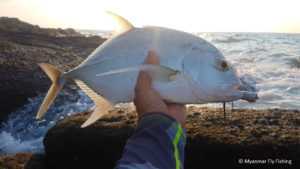
Barramundi, Lates calcarifer
This species has an elongated body form with a large, slightly oblique mouth and an upper jaw extending behind the eye. The lower edge of the preoperculum is serrated with a strong spine at its angle; the operculum has a small spine and a serrated flap above the origin of the lateral line. Its scales are ctenoid. In cross section, the fish is compressed and the dorsal head profile clearly concave. (more...)
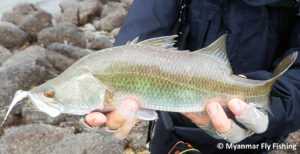
Great Barracuda, Sphyraena barracuda
Great barracudas are large fish. Mature specimens are usually around 60–100 cm (24–39 in) in length and weigh 2.5–9.0 kg (5.5–19.8 lb). Exceptionally large specimens can exceed 1.5 m (4.9 ft) and weigh over 23 kg (51 lb). The record-sized specimen caught on rod-and-reel weighed 46.72 kg (103.0 lb) and measured 1.7 m (5.6 ft), while an even bigger specimen measured 2 m (6.6 ft). (read more...)
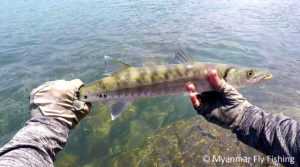
Mangrove Red Snaper, Lutjanus argentimaculatus
Coloration of the mangrove red snapper ranges from burnt orange, to copper, to bronze and dark reddish-brown, depending on its age and environment. Younger fish caught in estuarine areas are often darker than older fish taken from offshore reef areas, and exhibit lighter vertical bands down their flanks. (read more...)
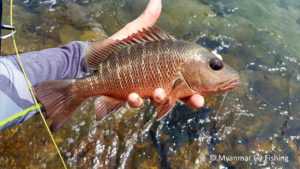
Largespotted Dart, Trachinotus botla
Dorsal spines (total): 7; Dorsal soft rays (total): 22-24; Anal spines: 3; Anal soft rays: 19 - 22. Bluish black above, silvery below; 1-5 large spots on or near lateral ligne (absent in specimens less than 15 cm, number of spots increasing with age); caudal, 2nd dorsal and anal fins dusky to blue-black, the lobes usually darker. (read more...)
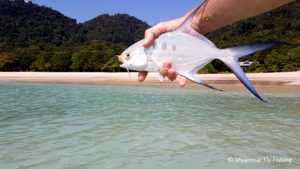
Checkered Snapper, Lutjanus decussatus
Dorsal spines (total): 10; Dorsal soft rays (total): 13-14; Anal spines: 3; Anal soft rays: 8 - 9. Dorsal profile of head moderately sloped. Preorbital bone usually about equal to eye diameter or slightly narrower. Preopercular notch and knob poorly developed. Scale rows on back rising obliquely above lateral line. Generally pink to whitish, with a silvery sheen on breast and side of head. Trunk with a `checker-board' pattern on upper half of sides. Horizontal stripes brown 5-6. Caudal fin base with large black spot. (read more...)
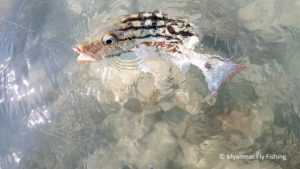
Flat Needle Fish, Ablennes hians
Although they have no spines, they do have several soft rays. About 23-26 rays are on the dorsal fin and 24-28 are on the anal fin. They have 86-93 vertebrae. Dorsally, flat needlefish are blueish, white ventrally, with dark blotches and 12-14 vertical bars in the middle of their bodies. Flat needlefish have elongated bodies, with scythe-shaped pectoral and anal fins. They also have a dark lobe on the posterior part of their dorsal fins. The longest recorded flat needlefish measured 140 cm. Measurements for flat needlefish body length do not include their caudal fins and heads because the fish's long jaws are often broken off. The largest recorded weight for a flat needlefish was 4.8 kg. (read more...)
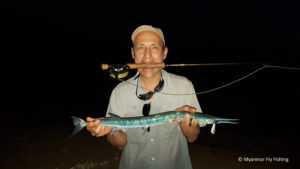
Silver sillago, Sillago sihama
The Silver sillago, or northern whiting's similarity to all other species in the genus Sillago has led to many less abundant species being confused with it. The species is known to grow to a maximum size of 31 cm, however reports dating back to 1850 in Bengal suggest the species attains 3 feet (91 cm), which would make it the largest species of sillaginid. These reports were never etched into the literature on the species, possibly because of presumed confusion with the similar but unrelated and larger milkfish and bonefish that inhabit the area. The species has a slightly compressed, elongate body tapering toward the terminal mouth. The dorsal fin is in two parts, the first made of feeble spines and the second of soft rays headed by a single feeble spine, while the ventral profile is straight. (read more...)
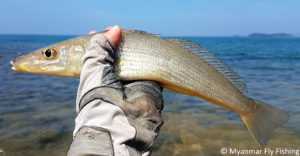
More to come...!!!
There are more salt water sport fish along Myanmar coastline, including big, strong fighters. We are working to locate these species and understand how to best catch them on fly...


